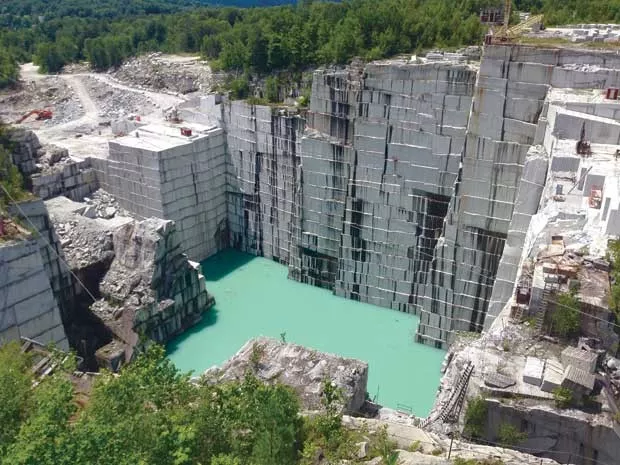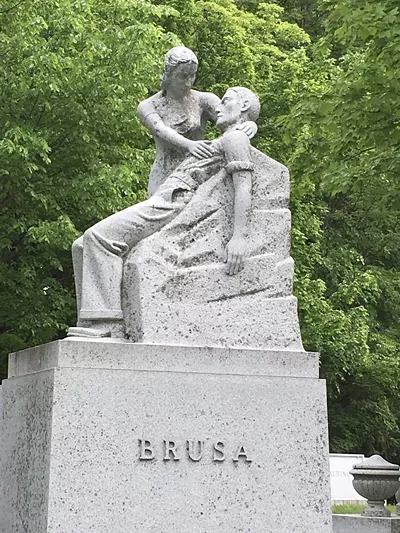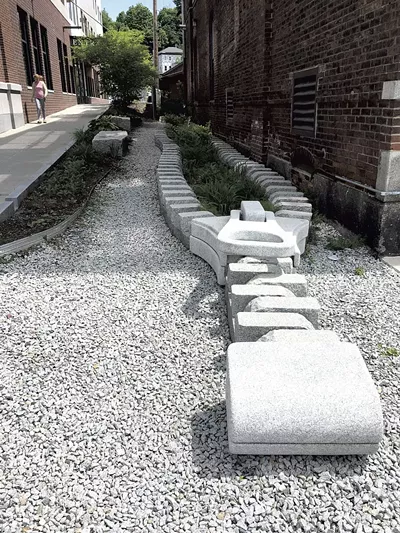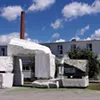Rock of Ages, which last summer celebrated 100 years of welcoming visitors to tour its world-class granite quarry and stone-sculpting operation, will no longer be open to the public.
“After more than a century as a cherished Vermont tourist destination, we have made the difficult decision to close the Rock of Ages Visitors Center and end public access to our quarries and self-guided tours,” Polycor, the Québec City company that owns Rock of Ages, posted on its website. The company said its decision was related to visitor safety concerns, evolving regulations and its operational needs.
Rock of Ages is the home of the majestic E.L. Smith Quarry, the largest operating deep-hole, dimension granite quarry in the world. Generations of visitors have gazed into its 600-foot-deep hole, where white stone walls rise vertically around an otherworldly teal blue pool. A deep-hole dimension quarry refers to one where large stone slabs are extracted.
In addition to the famous quarry, Rock of Ages boasts a 160,000-square-foot factory where, it says, about a third of the country’s granite monuments and headstone memorials are sculpted each year.
From May through October, visitors could see it all. They could watch sculptors at work; find informational films, educational displays and souvenirs in the visitors’ center; and try their hand at bowling in the one-lane outdoor granite alley — a prototype conceived in the 1950s as a potential replacement for traditional wooden lanes.
Everyone was welcome to take home a free chunk of granite.
Although closing its doors to the public marks “the end of a historic chapter, it also allows us to focus on the core aspects of our business and ensure the continued excellence of our craft,” the company statement said.
While the decision to close the visitors’ center is a blow to those who love towering heights and close-up views of Barre’s storied granite industry, it could be a boon to the Vermont Granite Museum. Tour bus reservations at the Barre museum for the coming year increased 21-fold over last year, from five to 106, after Polycor recommended the museum as an alternative to Rock of Ages in its announcement, according to museum executive director Scott McLaughlin.
Scott and other Barre boosters said they are sad to see the visitors’ center close. But they noted that it drew folks to a spot more than five miles away from the city’s historic center. And the Rock of Ages tour was focused on promoting Barre granite, not on local history, said artist Patricia Leahey Meriam, a board member and longtime supporter of the Granite Museum.
Tourists would “get off on Exit 6, go to the visitors’ center, see the manufacturing, get a little sales pitch to encourage them to maybe buy a headstone and get back on the highway,” Meriam said.
Now, she and others hope that bus visitors will stop not only at the Granite Museum but also at nearby Hope Cemetery, which serves as another museum of sorts — this one showcasing the memorials of granite carvers. Headstones include a race car, a soccer ball, figures, busts, obelisks and angels.
“Maybe they’ll have lunch in town,” Meriam said.
Barre granite is a durable gray stone so high in quality and consistency that some cemeteries only accept memorials made from it, McLaughlin said.
The stone has been quarried in central Vermont for centuries. By the early 1900s, Barre was sending granite by rail around the country, and 18,000 people worked in the city’s granite industry at its peak in 1929. The stone fueled the construction of grand homes, an opera house, a public library, several stone churches and other public buildings in Barre. Granite statutes and artwork decorate the downtown.
Rock of Ages says it has enough granite in its quarry to last another 4,500 years, citing measurements by Massachusetts Institute of Technology researchers who estimate the area’s granite vein to be four miles long, two miles wide and 10 miles thick.
The company started in 1885, when George B. Milne opened his first granite manufacturing company. In 1905, after several short-lived partnerships, he
joined forces with quarry owners James Boutwell and Harvey Varnum to form the Boutwell, Milne & Varnum company.
They opened their doors to onlookers in 1924. The trademarked phrase “rock of ages,” which the company used in a marketing campaign to emphasize the strength and quality of its granite, proved so resonant that the company renamed itself in 1925.
In 1962, Rock of Ages built a 2,800-square-foot visitors’ center to accommodate increased traffic. By 1967, the quarry and craftsmen center attracted more than 100,000 visitors each year. Its current visitors’ center opened in 2004.
As a historian who has dedicated his professional life to educating people about Vermont’s stonecutting industry, McLaughlin is pained that Barre is losing an opportunity for visitors to see the granite industry in action.
“It was one of the few sites worldwide where you had direct access as a visitor to the industrial site,” he said of the Rock of Ages tour. “Here was an opportunity for the public to see for themselves the stone being cut and hauled to the manufacturing plant, the process of going from a block to finished product.”
He also noted that the Vermont Marble Museum closed its doors last fall, putting an end to another opportunity, this one in Proctor, to educate visitors about Vermont’s stone industry. Marble is still quarried near Rutland.
“One of the most difficult things is that the public will start to think the quarries are closed,” McLaughlin said. “They’re not. They’re operating.”
Rock of Ages said in its announcement that the decision to close the quarry to visitors was “not made lightly.”
“It reflects our commitment to adapting to evolving site regulations and operational needs while prioritizing the safety of visitors and the integrity of our facilities,” the company said. It also directed people interested in learning more about the industry to the Vermont Historical Society and Barre’s Millstone Grand Lookout, a property that offers views of quarry holes.




